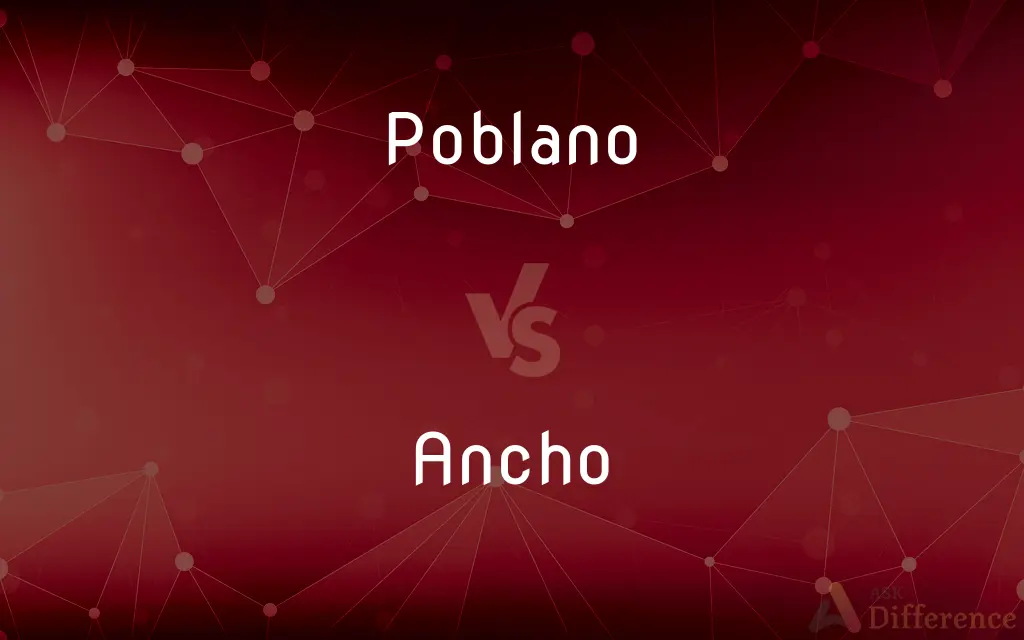Poblano vs. Ancho — What's the Difference?
By Tayyaba Rehman & Urooj Arif — Updated on April 27, 2024
Poblano peppers are fresh, mild chili peppers commonly used in Mexican cooking, whereas ancho peppers are dried poblanos with a sweet and mild flavor.

Difference Between Poblano and Ancho
Table of Contents
ADVERTISEMENT
Key Differences
Poblano peppers are fresh, green, and have a mild heat level, typically ranging between 1,000 to 2,000 Scoville units. On the other hand, ancho peppers are the dried form of poblano peppers, taking on a deeper, reddish-brown color and a sweeter taste as they lose moisture and concentrate in flavor.
In culinary uses, poblanos are often stuffed or used in fresh salsas due to their size and mild heat. Whereas anchos are ground into a powder or rehydrated in water to be used in sauces and rubs, adding a rich depth to dishes.
The texture of a poblano is crisp and juicy when fresh, which is ideal for grilling or roasting. Conversely, ancho peppers become leathery and pliable when dried, which makes them perfect for blending into a smooth, thick sauce.
Growing conditions affect their taste significantly; poblanos grow on a bushy plant under full sun, developing a crisp, mildly spicy flavor. In contrast, after being harvested and dried, anchos undergo a change that enhances their sweetness and complexity.
Nutritional content varies slightly due to the drying process. Poblanos contain more vitamin C and vitamin A per gram compared to their dried counterpart. However, ancho peppers have a higher concentration of minerals due to the reduction in water content.
ADVERTISEMENT
Comparison Chart
State
Fresh
Dried
Color
Green to dark red
Reddish-brown
Flavor
Mild and slightly spicy
Sweet with a hint of spiciness
Culinary Uses
Stuffed, roasted, used in salsas
Used in sauces, moles, rubs
Nutritional Value
Higher in vitamin C
Higher in concentrated minerals
Compare with Definitions
Poblano
A type of chili pepper that is mild in heat and large in size.
Poblano peppers are often stuffed with meat and rice for chiles rellenos.
Ancho
A dried poblano pepper with a sweet and mild flavor.
Ancho peppers are essential for making authentic Mexican mole.
Poblano
Contains a significant amount of vitamin C.
Eating poblano peppers can help meet your daily vitamin C needs.
Ancho
Rich in minerals due to reduced water content.
Ancho peppers contribute essential minerals to a balanced diet.
Poblano
Commonly used fresh in Mexican cuisine.
Fresh poblano peppers add a mild kick to any salsa.
Ancho
Often ground into a powder for culinary uses.
Ground ancho pepper is used to season meat and vegetables.
Poblano
Grows in a bushy plant under full sun.
The poblano plant in my garden has just started flowering.
Ancho
Commonly used in dried form in various cuisines.
Dried ancho peppers add complexity to stews and soups.
Poblano
Can be roasted and peeled for a smoky flavor.
Roasted poblano peppers are perfect for adding to a taco.
Ancho
Takes on a leathery texture when dried.
Ancho peppers must be rehydrated before blending into sauces.
Poblano
The poblano (Capsicum annuum) is a mild chili pepper originating in the state of Puebla, Mexico. Dried, it is called ancho or chile ancho, from the Spanish word ancho ("wide").
Ancho
A dried poblano pepper.
Poblano
A cultivar of the tropical pepper Capsicum annuum, having a mild or fairly pungent dark green, thick-skinned fruit used in cooking.
Ancho
A broad, flat, dried poblano pepper, often ground into a powder.
Poblano
A mild green chile pepper native to Mexico; when dried, the chilis are called anchos or wide chilis.
Common Curiosities
How do you prepare ancho peppers for cooking?
Ancho peppers should be rehydrated in hot water or ground into a spice powder before cooking.
Can you eat ancho peppers raw?
Ancho peppers are typically not eaten raw as they are dried; they are used rehydrated or ground into powder.
Are poblano peppers the same as bell peppers?
No, poblanos are spicier and smaller than bell peppers, although they are also mild compared to other chilies.
What are common dishes using poblano peppers?
Common dishes include chiles rellenos, poblano cream sauces, and poblano salsa.
What nutritional benefits do ancho peppers offer?
They are a good source of iron, potassium, and fiber, especially when concentrated in the dried form.
Can I substitute ancho pepper for fresh poblano in recipes?
Substituting one for the other depends on the recipe, as their textures and moisture content are very different.
Do ancho peppers taste like chipotle peppers?
Ancho peppers are milder and sweeter than chipotle peppers, which are also smoked.
How do I rehydrate ancho peppers?
Soak them in hot water until they are pliable, usually about 15 to 30 minutes.
What is the Scoville rating of poblano peppers?
Poblano peppers have a mild heat, with a Scoville rating of 1,000 to 2,000 units.
Can poblano peppers be eaten without cooking?
Yes, they can be eaten raw and are often used fresh in salads or salsas.
What is a good substitute for ancho peppers in recipes?
Mulato or pasilla peppers can be used as substitutes for a similar flavor profile.
How do you dry poblano peppers to make ancho peppers?
Poblanos are dried in the sun or a dehydrator until they lose all moisture and turn dark.
What's the best way to store poblano peppers?
Store them in the refrigerator's vegetable drawer, where they can last for about a week.
What are the health risks of consuming poblano or ancho peppers?
Generally, they are safe to eat; however, those with spicy food sensitivities should consume them in moderation.
How spicy are ancho peppers compared to other dried chilies?
Ancho peppers are on the milder side compared to other dried chilies like de arbol or habanero.
Share Your Discovery

Previous Comparison
Dinosaur vs. Dragon
Next Comparison
Coal vs. EmberAuthor Spotlight
Written by
Tayyaba RehmanTayyaba Rehman is a distinguished writer, currently serving as a primary contributor to askdifference.com. As a researcher in semantics and etymology, Tayyaba's passion for the complexity of languages and their distinctions has found a perfect home on the platform. Tayyaba delves into the intricacies of language, distinguishing between commonly confused words and phrases, thereby providing clarity for readers worldwide.
Co-written by
Urooj ArifUrooj is a skilled content writer at Ask Difference, known for her exceptional ability to simplify complex topics into engaging and informative content. With a passion for research and a flair for clear, concise writing, she consistently delivers articles that resonate with our diverse audience.
















































